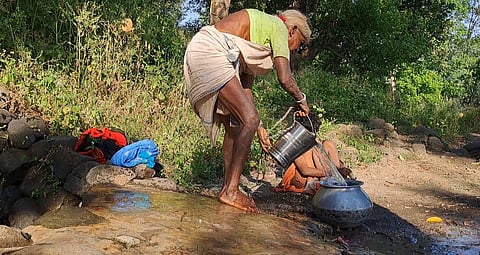
Bhopal: Numerous tribal villages in Anuppur district still lack essential infrastructure such as roads, potable water, and electricity. Speaking with The Mooknayak, 24-year-old Shamli Bai from Baigantola village lamented, "We live in perpetual darkness with little hope for illumination. Bringing electricity to our village seems like an unattainable dream. We burn wood for light in the evenings and cherish moonlit nights when the village is naturally illuminated."
Situated approximately 600 kilometers from Bhopal, the villages in Anuppur district, predominantly inhabited by the Baiga tribe, are still deprived of basic amenities. To comprehend their struggles, The Mooknayak team ventured into Pushparajgarh, an area where government-provided basic facilities are conspicuously absent.
The Baiga community, classified as a Particularly Vulnerable Tribal Group (PVTG), resides in Anuppur. Many of these areas and villages are devoid of roads, making them accessible only on foot. Our first destination was Gadidadar village under Bodha gram panchayat in Pushparajgarh, with a population of about 900. Despite being independent for decades, this village has yet to see electricity.
Speaking with The Mooknayak representative, Indravati from Gadidadar recounted, "Eight years ago, I married Surendra Singh from this village. Upon my arrival, I was told that electricity would be supplied soon. Yet, eight years later, we are still waiting."
Other villagers echoed her sentiments, expressing frustration over unfulfilled promises. They stated that assurances of electricity are given during election campaigns, but no action follows. Panchayat Secretary Nandkishor Sariwan confirmed that although poles were installed years ago, electricity has not been provided.
After visiting Gadidadar, we proceeded to another village in Pushparajgarh, which is entirely isolated from urban areas due to the absence of road access for vehicles.
Baigantola village, located about 5 kilometers from the nearest road, is under the jurisdiction of Gutti Para gram panchayat. The two hamlets situated on the mountain lack essential amenities such as electricity, water, roads, healthcare, and education for the Baiga tribe residing there.
The houses in Baigantola are rudimentary huts, and the village population, around 200, is divided into two hamlets. The villagers engage in primitive farming, with some traveling outside the village for labor. Despite numerous appeals to representatives and officials, basic facilities remain inadequate. The village suffers from a severe water crisis, relying on natural water sources known as 'jhiriya' (small pits).
Jhiriya are natural water sources where small pits are dug at the base of the mountain, and these pits are lined with stones to collect water that trickles down the mountain overnight. This water, however, is not entirely safe, leading to health issues among the villagers. Village sarpanch Daduram Panadia informed The Mooknayak , "Villagers are consuming contaminated water, resulting in illnesses. Many deaths occur because we cannot transport patients to the hospital. Baigantola lacks roads, electricity, and adequate water facilities."
Shamli Bai, 24, shared her experience of living in darkness, holding onto little hope for light. She remarked that bringing electricity to the village seems like an unattainable dream. Shamli mentioned that they light fires for evening activities but must complete tasks quickly as working in the dark is challenging.
She explained that the village has a rule limiting the use of wood, even though it is freely available from the forest. Consequently, most nights are spent in darkness. Shamli added, "We cherish moonlit nights because the village is illuminated." She pointed out that there is no road connecting the village to the main road, and no government official has ever visited them, except for the sarpanch and the panchayat secretary, who come once a month from the lower village.
Baigantola consists of two separate hamlets. To travel from one hillock to another, about 800 meters of walking is required. To ease this journey, the villagers themselves forged a path. Gradually, they carved through sections of the hillock, creating a rudimentary trail that allows for easier movement between the two hamlets.
Despite the educational challenges in Baigantola, the sarpanch, Daduram, is well-educated. He explained that living in a village adjacent to a road made attending school feasible for him. However, the residents of Baigantola struggle to access education due to the poor condition of the road leading to the main road. Although there is a primary school in the village, teachers frequently fail to attend, leaving the school nearly non-functional. For secondary education, children must travel to Gutti Para village, a journey that proves arduous and challenging on a daily basis.
You can also join our WhatsApp group to get premium and selected news of The Mooknayak on WhatsApp. Click here to join the WhatsApp group.